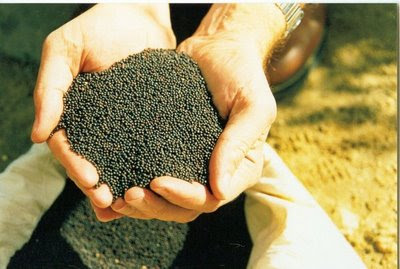. Sara
Sara asked for a run down on Margarine.
Normally the image sold to us with margarine is like the one above.
Mother Nature at her most adorable best.
In reality, canola seeds, the main source of oil for most domestic margarine and a close relative of rapeseed and mustard seed, looks like this:
 Wholemeal margarine
Wholemeal margarine
For convenience, I will limit myself to the manufacturing steps to make canola-based margarines. The process is largely as follows:
1. Grind the seeds and extract the oil using petroleum solvent, usually hexane. Remove as much as possible of the hexane from the oil. The oil at this stage is a greeny-brown colour and has a nutty odour.
2. Treat the oil with caustic soda to neutralise free acids and precipitate gums.
3. Heat the oil with clay to bleach it to a pale yellow colour.
4. Deodorise the oil to remove unpleasant tastes and smells – this is usually done with steam and vacuum.
At this point you have vegetable oil, as you would buy it in the shops. Now...
5. Heat the oil under pressure and heat with finely divided nickel and hydrogen gas to saturate the double and triple bonds in the oil and create a fat that is solid at room temperature. Attempt to minimise the production of trans fats while doing this. The product is now solid, white and bland.
6. Add about 20% water or milk plus emulsifier (typically lecithin) to keep the water-oil suspension stable.
7. Add flavours (usually milk and/or milk solids) to give taste. Salt may also be added.
8. Add vitamins A & D to fortify it.
9. Add colour to make it look more appealing.
10. Put a lid on it.
-----------
Margarine has the same fat content (80-85%) as butter.
Margarine has the same calories as butter.
Margarine use was widely adopted when someone said butter was bad. No-one stopped to wonder if margarine was good. It just wasn't butter and butter was bad. Presumably butter was bad because it contained cholesterol. Now the notion that dietary cholesterol is a problem has been largely discredited. The concern now centres on the saturated fats in the diet.
Butter does have higher saturated fat levels than margarine.
The other thing to be aware of is that there is table margarine and cooking margarine. Cooking margarine is used in the biscuit and cake industry and is a harder (more saturated) fat than table margarine.
Is margarine bad?No, not bad in the 'avoid at all costs' sense but nor is it 'natural' in the way the advertisers and their sunny yellow fields would like us to believe.
...



